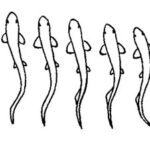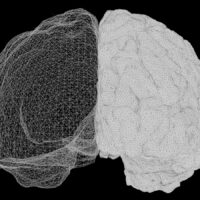Fins are among the most recognizable features of a fish and come in a variety of forms. Most fish have two main types of fins: median and paired fins. Median fins are single fins that run along the midline of the fish’s body, including the dorsal, caudal (tail), and anal fins. Paired fins, on the other hand, are found in pairs on either side of the body these are the pectoral and pelvic fins, which are somewhat similar to human arms and legs.
Fins play a crucial role in swimming and maintaining balance. They can also help scientists and enthusiasts identify different fish species.
There are mainly two types of fins in fishes:
(1) Unpaired or median fins
(2) Paired lateral fins
(1) Unpaired Median Fins:
These include 1 or 2 dorsal fins along mid-dorsal line, a ventral anal fin behind anus or vent (cloaca) and a tail or caudal fin around the tip of tail. Dorsal fins may be in a series or reduced or absent. Anal fins may be absent especially in bottom dwellers.
(2) Paired Lateral Fins:
The paired fins are the pectorals and pelvics corresponding to the fore- and hind-limbs of the terrestrial vertebrates. These include pectoral fins anteriorly and pelvic fins posteriorly.
Pelvic fins are called thoracic when placed below the pectoral fins and abdominal when situated just in front of anus. In some cases they are absent.
Both the unpaired median and paired fins are supported by skeletal rods called radials and dermal fin rays. A great variety of fins is observed in fishes. The diversity in fin system in fishes is due to their adaptive responsiveness.
Origin of Fins
The first chordates lacked paired appendages but it is universally accepted that tetrapod limbs arose during evolution from the fins of fishes. However, clues to the origin of fins themselves have remained obscure and unresolved. The median or unpaired fins in fishes are believed to have originated from a continuous fold of tissue.
These folds extend from the posterior region of the head and continue posteriorly around the tail and extend up to anus. This fold of skin is supported by a series of parallel cartilaginous rods. During the course of development each supporting rod divides into a lower basal piece, embedded in the body wall and an upper radial piece, lying in the fin fold.
From such a continuous fin-fold, the dorsal, caudal and anal fins have been evolved by restriction of radials at certain areas and the progressive degeneration of fold between them.
Several theories have been advanced to explain the source and manner of origin of fins:
a. Gill-Arch Theory:
According to the gill-arch theory of Gegenbaur proposed in the nineteenth century, the paired fins are modified gill structures, the girdles represent the gill- arches and the fin folds with their skeleton represent gill-flaps or septa.
The position of the pelvic fins can be explained on the assumption that some of the posterior gill-arches have been shifted posteriorly. This idea finds no support from morphological, embryological and palaeontological studies.
b. External Gill Theory:
According to Graham Kerr, paired fins and their skeleton are derived from external gills which occur temporarily in some larval forms. However, this theory has no supporting evidence.
c. Fin-Fold Theory:
This theory was first proposed by Balfour and Thacher and later supported by Mivart. A number of eminent vertebrate morphologists like Wiedersheim, Haswell, Regan, Sewertzoff Osburn and Goodrich have presented several evidences in support of this theory. According to this theory, the paired fins have originated from a paired lateral continuous fin-folds running down each side of the body behind the gill-openings up to the end of the tail.
These lateral fin-folds were separate in the anterior part but fused in the caudal region behind the anus, forming a ventral fin-fold. Besides these, there was a dorsal median 4 # Fish and Fisheries fold. The condition of the lateral fin-folds in the ancestral forms was presumably like the metapleural folds of Branchiostoma. There are many palaeontological and embryological evidences in favour of origin of the paired fins from the lateral fin-folds.
Some of the evidences are:
(i) Basic skeletal structures of paired and unpaired fins are similar indicating a common mode of origin.
(ii) In the embryos of certain elasmobranchs, early stages show continuous series of muscle bands which disappear, except those forming the isolated paired and unpaired fins.
(iii) In some extinct Devonian acanthodian sharks, a row of numerous small accessory spiny fins on either side between pectoral and pelvic fins, have been interpreted as remnants of fin-folds.
(iv) In the extinct shark Cladoselache, the pectoral and pelvic fins are broad, without basal notches and supported by parallel cartilaginous rods (pterygiophores) suggesting a primitive fin-folds-like origin.
(v) In Climatius, there was a series of smaller spines and finlets between the pectoral and pelvic fins. This suggests that they were originally joined by a continuous fold.
The idea of the fin-fold origin of the paired and unpaired fins in fishes is supported by anatomical, embryological and palaeontological evidences. This theory was accepted by most of the workers in this field of research.
d. Fin Spines Theory:
According to this theory, recent workers claim that the so-called “several pairs of fins” in acanthodians indicate nothing but a special kind of multiplication of the defensive spines, which may often support membranous structures. Subsequently all spines and webs may have been lost except one anterior and one posterior pair which later evolved into pectoral and pelvic fins.
Furthermore, no true primitive fossil fish with completely continuous fins is still known.
This observation compels the recent workers to discard the fin-fold theory. They suggest that the fin appeared probably in connection with some paired and unpaired median spines, as found in many ostracoderms. In course of evolution membranous structures appeared between these spines and the adjacent body wall.
e. Ostracoderm Theory:
Some ostracoderms possessed lateral fleshy lobes, projecting from either lateral side. They may have been the precursors of pectoral fins. Other ostracoderms had ventro-lateral rows of dermal spines similar to extra fins of acanthodians. Most of these spines were lost while some were retained in the pectoral and pelvic regions, thus, accounting for the origin of paired fins (and limbs) from ostracoderm ancestors.
Different Types of Fish Fins
1. Dorsal Fin
This type of fin is located on the top or back of the fish, which helps the fish make quick turns or stops. It also helps prevent the fish from rolling. In fish, there are three distinct dorsal fins: proximal, central or middle, and distal dorsal fins. Some fish have two dorsal fins where the central and distal fins are combined together.
Types of Dorsal Fins
- Single
- Pointed
- Split
- Spine triangular
- Trigger
- Trailing
2. Pelvic Fin
In fishes, a pair of pelvic fins are present which are located ventrally below and behind the pectoral fins. In some fishes, they are situated in front of the pectoral fins (Cod family). This type of fin helps with stability and slowing down the fish. Generally, fish use pelvic fins for moving upwards and downwards in the water.
3. Anal Fin
The anal fin is also known as the cloacal fin, which is located on the ventral side just behind the anus. It supports the dorsal fin and stabilizes the fish during swimming and controls the rolling motion.
4. Pectoral Fin
Pectoral fins are located on both sides, usually just behind the operculum. They are homologous to the tetrapod’s forelimbs. They provide support during swimming. They create dynamic lifting force and also help the fish to turn left or right.
5. Adipose Fin
These are soft fins located between the dorsal and caudal fins, usually very near to the caudal fin. They are mainly found in Salmonidae, Characins, and catfishes. This type of fin helps to navigate the fish in rough water.
6. Caudal Fin
The caudal fin is the primary appendage which is used for locomotion in many fishes. The caudal fin is also known as the tail fin or a median fin, which is usually homocercal or heterocercal. Generally, it is a vertically expanded structure which is located at the caudal end of the body. The base of the caudal fin is known as the caudal peduncle with strong swimming muscles. In general, the caudal fin acts like a propeller while the caudal peduncle functions as a motor.
The caudal fin has two lobes: dorsal epichordal and ventral hypochordal lobes, which are supported by the modified last three caudal vertebrae. The shape of the caudal fin may vary in different species from rounded to pointed, notched, emarginated, truncated, etc. It is used to identify fish species. Generally, fish use it for forward propulsion and speed.
6.1 Categories of Caudal Fins
The caudal fin of adult fishes may be grouped into three categories:
A) Protocercal Caudal Fin
It is the most primitive type of caudal fin where the straight vertebral column divides the caudal fin into two equal lobes: upper lobe and lower lobe. In this case, the upper lobe is known as epichordal or epicaudal and the lower lobe is called hypochordal or hypocaudal lobe. A series of rods are arranged around the central axis of the caudal region, which support the fin membrane. Undoubtedly, during the developmental period, the caudal fin of all fishes passes through the protocercal stage. This type of fin is found in cyclostomes and the living dipnoans (lungfishes).
B) Heterocercal Caudal Fin
The heterocercal tail is sometimes called the shark-tail type of caudal fin. Elasmobranchs (cartilaginous fish) and some primitive types of bony fishes contain this type of fin. This fin has two unequal lobes where the upper smaller lobe is known as the epichordal lobe and a much larger lower lobe is known as the hypochordal lobe. In this case, the hind end of the vertebral column becomes bent upwards and continues almost up to the tip of the fin.
C) Homocercal Caudal Fin
Most of the higher teleosts have homocercal caudal fins. They have superficially symmetrical and two equal-sized lobes: upper epichordal and the lower hypochordal lobe. Internally, this tail is asymmetrical, with the rear section of the vertebral column significantly shortened and angled upward. In this case, the vertebral column does not touch the posterior limit of the fin.
Varieties of Caudal Fins
The internal and external structure of caudal fins varies, which depends on the swimming habits of the fish. Generally, these variations involve special modification of the vertebral column. The following seven main types of caudal fins are found in fishes:
1. Lunate or Crescentic: Used for continuous long-distance swimming. e.g. Tuna
2. Forked: Used for rapid swimming, e.g. Herring, Mackerel
3. Emarginate: e.g. Trout, Carp, Perch
4. Truncate: Aids in turning quickly. e.g. Flounder
5. Rounded: Used for slow swimming, accelerating, and maneuvering. e.g. Turbot and Lemon Sole
6. Pointed: e.g. Goby
7. Double emarginate
Modifications of Caudal Fin
Many fishes have specialized modified types of caudal fins such as:
(1) Isocercal or Leptocercal
In some fishes, tapering and symmetrical types of fins are present which are known as isocercal or leptocercal caudal fins. In this case, the spine is long with a straight rod-like structure. Rat tails (Macrouridae), Blennies (Blenniidae), Eels (Anguilliformes), feather backs (Notopteridae), and Gymnarchids (Gymnarchidae), etc. have the isocercal caudal fin.
(2) Internally Symmetrical Caudal Fin
This is a reduced type of caudal fin where some fin elements are fused together. They are found in cods (Order: Gadiformes).
(3) Pseudocaudal Caudal Fin
In the modern lungfishes (Dipnoi), the pseudocaudal caudal fins are found. In this case, fins are developed from the backward growth of dorsal and ventral elements.
(4) Hypocercal Caudal Fin
This type of caudal fin bears a much larger dorsal lobe than the ventral lobe, which is greatly reduced. They are found in certain early Agnathans. It is also known as inverted heterocercal caudal fin. In this case, the vertebral axis turns downwards sharply where the lobe develops from its upper surface.
(5) Gephyrocercal Caudal Fin
It is a very specialized type of caudal fin which is also known as bridge caudal fin. Generally, they look like the isocercal fin but the fins are reduced to vestiges. In this case, the caudal lobe is truncated where hypurals of the spinal column are lacking. These types of fins are found in the pearlfishes (Carapus), Fierasfer and Orthagoriscus.
Functions of Fins
Fish use their fins for various purposes. Some important functions of fins are described below:
REFERENCES
- Fish and Fisheries – B. N. Yadav
- A Textbook of Fish Biology and Fisheries – S. S. Khanna & H. R. Singh
- Introduction to Fishery Science – B. K. Tiwari & S. C. Pathak


















